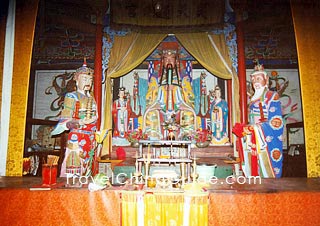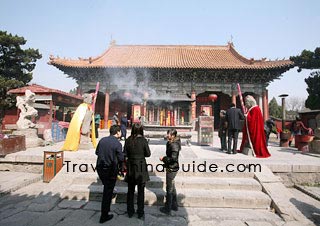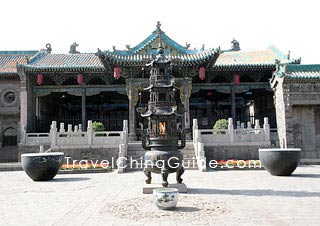Taoist Temples in China
 |
| Yuquan Temple, Tianshui, Gansu |
Taoist temples of different scales are scattered all over China. Generally, they can be divided into three kinds: palace-like and ordinary temples, and simple hut or caves. Though of various sizes, they are built to serve the same function.
People may get confused in distinguishing a Taoist temple from a Buddhist temple because they are much alike from the outside. It is true that many methods of Taoist construction imitate those of Buddhism, but there exist some minor difference between them. For example, the holy statues of Dragon and Tiger are set in front of the main gate of a Taoist temple, while statues of two giants guard in the same position in a Buddhist one. The Taoist trinity, San Qing (Three Pure Gods), is worshipped in Taoist halls. They are Yu Qing (Jade Pure), Shang Qing (Upper Pure) and Tai Qing (Great Pure). In the main hall of a Buddhist temple on the other hand, the Buddha trinity is placed. Besides, themes of statue and murals in Chinese Taoist temples are those familiar to common people and the religious atmosphere is not as intense as in Buddhist temples.
|
|
Taoism encourages human beings to live harmoniously with nature. Most Taoist temples are built along a mountain side. Many of them are wooden-framed, which is believed to be beneficial to health.
Related Link: Taoist Architecture Style, Hall of Imperial Peace (Qin’andian) in Forbidden City
Chinese Temples
- Buddhist Temples
- Taoist Temples
- Islamic Mosques
- Confucius Temples
- Chinese Temples Pictures
- Last updated on Nov. 14, 2023 -
Questions & Answers on Taoist Temples in China
Asked by Ivana from CROATIA | Jul. 16, 2023 10:00 Reply
Reply
Need help identifying this item in Taoist temple
What are those decorated things in front of every Taoist temple? They look like big black bowl, with handles on the side and roof over them. What is their purpose? Not an incence burner since those are fairly recognizable and still in use, but something else - what?
Answers (2)
Answered by Emma | Jul. 17, 2023 22:39 0
0 0
0 Reply
Reply
I cannot think of other items except an incence burner.
Answered by Logan | Nov. 14, 2023 11:54 0
0 0
0 Reply
Reply
It might be a furnace that they used to "refine pills of immortality". It is mentioned in this other article from travel china guide: https://www.travelchinaguide.com/intro/architecture/styles/taoist.htm
Asked by JOHN P from OZ | Oct. 27, 2016 19:58 Reply
Reply
When first entering a Taoist temple, should I step in with the LEFT or the RIGHT foot ?
I was told there is a protocol for this.
Answers (1)
Answered by Angela from SINGAPORE | Oct. 30, 2016 21:57 0
0 0
0 Reply
Reply
As I know, one should step in with the left foot if he goes through the left door and move right foot first when entering from the right door. One should also avoid using the middle door to get in and out.
Asked by Mickey Sim from SINGAPORE | Jun. 21, 2016 08:51 Reply
Reply
Kindly list the top ten taoist temples in china please.
Answers (1)
Answered by Richards from ITALY | Jun. 21, 2016 20:50 2
2 0
0 Reply
Reply
Oh, I have done some researches before about this question. Hereunder is the details:
1. White Cloud Temple in Beijing
2. Changchun Temple in Wuhan
3. Xuanmiao Temple in Suzhou
4. Jinhua Temple in Jinhua City Zhejiang Province
5. Five Immortals Temple in Guangzhou
6. Yanqing Temple in Kaifeng
7. Zhengyi Temple in Yingtan City Jiangxi Province
8. Zhenwu Temple in Xiangyang City Hubei Province
9. Huixian Temple in Changzhi City Shanxi Province
10. Jiaying Temple in Jiaozuo City He'nan Province
1. White Cloud Temple in Beijing
2. Changchun Temple in Wuhan
3. Xuanmiao Temple in Suzhou
4. Jinhua Temple in Jinhua City Zhejiang Province
5. Five Immortals Temple in Guangzhou
6. Yanqing Temple in Kaifeng
7. Zhengyi Temple in Yingtan City Jiangxi Province
8. Zhenwu Temple in Xiangyang City Hubei Province
9. Huixian Temple in Changzhi City Shanxi Province
10. Jiaying Temple in Jiaozuo City He'nan Province
Asked by Chris | Jan. 12, 2016 13:31 Reply
Reply
What do taoists call priests? What is the name of highest temple in taoism, just as we have vatican for the catholics
Answers (1)
Answered by Rita from MALAYSIA | Jan. 14, 2016 03:15 1
1 2
2 Reply
Reply
Did you how to call them in Chinese? Taoists call them Zhen Ren or Shi Zun. Actually, there are four famous Taoist sites, Mt. Wudang, Mt. Qingcheng, Mt. Longhu and Mt. Qiyun. Among the four mountains, Mt. Wudang and Mt. Qingcheng are the most famous ones.
Asked by Nimi from USA | Feb. 24, 2015 21:14 Reply
Reply
is there any way a westerner could live and learn in these taoist temples?
Answers (1)
Answered by Manuel from ROMANIA | Feb. 27, 2015 02:06 0
0 0
0 Reply
Reply
Hey, how about China Taoist College, which is located inside
White Cloud Temple located at east side of Baiyun Road, outside of Fuxing Gate, Xicheng District.
White Cloud Temple located at east side of Baiyun Road, outside of Fuxing Gate, Xicheng District.

